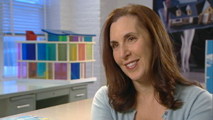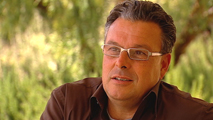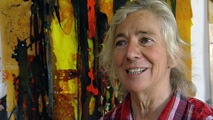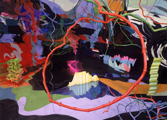code flow - events
Exclusive Preview - Episode "Romance"
3 October 2007, 18h30
at
 EPISODE ONE: Romance
EPISODE ONE: Romance
Premieres on PBS (in the US) on Sunday, October 28, 2007, at 10:00 p.m. ET
Episode Description
What role do intuition, emotion, fantasy, and escapism play in contemporary art? How do contemporary artists respond to traditionally romantic ideals such as sentimentality, pathos, and the philosophy of art for art’s sake? Episode One poses questions about the value of pleasure in art and features artists whose works are extended meditations on mortality, love, reality and make-believe.
 Early in her career, Laurie Simmons used photography as a tool to create a still and pristine reality – with images that played with dollhouse-sized furniture or a pair of high heels – in contrast to the chaos of everyday life. Simmons explains how she was able to bring her still photographs to life in her recent and first feature film, The Music of Regret (2006). Drawing from the American Songbook tradition, Simmons composed lyrics and storylines for the musical, which featured a cast of puppets, dummies, and dancers. “My inner life about my own work was very theatrical and very narrative, but that’s something I was always afraid to express,” says Simmons. “I had music in my head that was sort of playing while I was shooting.”
Early in her career, Laurie Simmons used photography as a tool to create a still and pristine reality – with images that played with dollhouse-sized furniture or a pair of high heels – in contrast to the chaos of everyday life. Simmons explains how she was able to bring her still photographs to life in her recent and first feature film, The Music of Regret (2006). Drawing from the American Songbook tradition, Simmons composed lyrics and storylines for the musical, which featured a cast of puppets, dummies, and dancers. “My inner life about my own work was very theatrical and very narrative, but that’s something I was always afraid to express,” says Simmons. “I had music in my head that was sort of playing while I was shooting.”  Viewers follow Simmons through portions of the three-act musical, which portrays complex emotions of love, loss, and regret. Inspired by three different stages of Simmons’s photographic work, the film features hand puppets, ventriloquist dummies and objects that come to life and enact scenes that resemble real life. In the first Act, “The Green Tie,” Simmons employs puppets to explore love and conflict among family and suburban neighbors. In Act Two, “The Music of Regret,” Academy Award-winning actress Meryl Streep portrays a “live” puppet, whose interaction with a ventriloquist dummy depicts a bittersweet relationship through their love song duets. In the film’s third and final Act, “The Audition,” Simmons works with members of the Alvin Ailey American Dance Theater to produce a stage performance that features everyday objects – a pocket watch, a camera, a birthday cake – dancing tango, tap and ballet at an audition before an unseen judge. “Regret is the prevailing emotion…that brings the three Acts together,” she says, “…it ends on a note of…what might have been, if I just had a chance.”
Viewers follow Simmons through portions of the three-act musical, which portrays complex emotions of love, loss, and regret. Inspired by three different stages of Simmons’s photographic work, the film features hand puppets, ventriloquist dummies and objects that come to life and enact scenes that resemble real life. In the first Act, “The Green Tie,” Simmons employs puppets to explore love and conflict among family and suburban neighbors. In Act Two, “The Music of Regret,” Academy Award-winning actress Meryl Streep portrays a “live” puppet, whose interaction with a ventriloquist dummy depicts a bittersweet relationship through their love song duets. In the film’s third and final Act, “The Audition,” Simmons works with members of the Alvin Ailey American Dance Theater to produce a stage performance that features everyday objects – a pocket watch, a camera, a birthday cake – dancing tango, tap and ballet at an audition before an unseen judge. “Regret is the prevailing emotion…that brings the three Acts together,” she says, “…it ends on a note of…what might have been, if I just had a chance.”
 Lari Pittman was born and works in Los Angeles. His references and background which inspire his work include the freedom and chaos of the city, his memories of growing up in Columbia and his “very, very strong Mediterranean core.” His meticulously-layered paintings transform decoration, pattern, and signage into elaborate scenes that illustrate complexity, difference, and desire. “I want to offer a painting that somehow…the viewer has to stand in front of it and almost not believe it,” says Pittman.
Lari Pittman was born and works in Los Angeles. His references and background which inspire his work include the freedom and chaos of the city, his memories of growing up in Columbia and his “very, very strong Mediterranean core.” His meticulously-layered paintings transform decoration, pattern, and signage into elaborate scenes that illustrate complexity, difference, and desire. “I want to offer a painting that somehow…the viewer has to stand in front of it and almost not believe it,” says Pittman.  “But in the act of not believing it, what they’re actually seeing, they get swept away in it.” As the documentary follows Pittman, he recounts a fond childhood memory from his early life in South America, and the encouragement and love he received as a young boy from his family, both of which he credits with his ability to grow, mature, and develop as a visual artist. “I think that that’s why the decorative aspect of the work comes systemically, organically, naturally to me because it was really allowed to bloom and blossom and wasn’t curtailed or curbed when I was a child.” Despite a charmed childhood, Pittman explains that what keeps him “radicalized” is an awareness of this country’s attitude towards the gay community. “I can lead quite a pretty life,” he says, “but it’s always quickly clarified by those very aggressive strains in American culture, which in a way…wonderfully puts me in my place.” He also explains how he draws inspiration from religious images and retablos as well as gardening and landscaping. “I don’t respond to the idea of nature at large. I prefer landscaping,” says Pittman, “…landscaping as a way to push back, a little bit, the chaos of nature…the kind of violence of it.”
“But in the act of not believing it, what they’re actually seeing, they get swept away in it.” As the documentary follows Pittman, he recounts a fond childhood memory from his early life in South America, and the encouragement and love he received as a young boy from his family, both of which he credits with his ability to grow, mature, and develop as a visual artist. “I think that that’s why the decorative aspect of the work comes systemically, organically, naturally to me because it was really allowed to bloom and blossom and wasn’t curtailed or curbed when I was a child.” Despite a charmed childhood, Pittman explains that what keeps him “radicalized” is an awareness of this country’s attitude towards the gay community. “I can lead quite a pretty life,” he says, “but it’s always quickly clarified by those very aggressive strains in American culture, which in a way…wonderfully puts me in my place.” He also explains how he draws inspiration from religious images and retablos as well as gardening and landscaping. “I don’t respond to the idea of nature at large. I prefer landscaping,” says Pittman, “…landscaping as a way to push back, a little bit, the chaos of nature…the kind of violence of it.”
 Born in England, Judy Pfaff came to America when she was twelve and later attended Yale University School of Art. Although she started out as a painter, Pfaff was drawn to materials and sculpture. As she explains, “I found when I was a painter I couldn’t stop and until it was finished another thought didn’t enter. With the sculpture, they go on for months. It tells different kinds of stories. They’re sort of sequence moments.
Born in England, Judy Pfaff came to America when she was twelve and later attended Yale University School of Art. Although she started out as a painter, Pfaff was drawn to materials and sculpture. As she explains, “I found when I was a painter I couldn’t stop and until it was finished another thought didn’t enter. With the sculpture, they go on for months. It tells different kinds of stories. They’re sort of sequence moments.  It worked better for the way I am put together.” Balancing intense planning with improvisational decision-making on site, Pfaff creates exuberant, sprawling sculptures and installations that blend landscape, architecture, and synthetic color into a tense yet organic whole. The documentary follows Pfaff through the installation of a recent exhibition, one which is driven by sadness and loss, using tree roots, neon tubes, and plaster forms, among others, to explore the worlds of black and white. Pfaff describes how the show came into being after the deaths of several close friends, her mother, and her former teacher and mentor, Al Held. “Last year, everyone I knew died,” she says. “I just thought, this show…I just want it to be emotional. So I was basing this sort of on images of…I don’t think hell, but darkness and kind of a wilder characteristic than other stuff.”
It worked better for the way I am put together.” Balancing intense planning with improvisational decision-making on site, Pfaff creates exuberant, sprawling sculptures and installations that blend landscape, architecture, and synthetic color into a tense yet organic whole. The documentary follows Pfaff through the installation of a recent exhibition, one which is driven by sadness and loss, using tree roots, neon tubes, and plaster forms, among others, to explore the worlds of black and white. Pfaff describes how the show came into being after the deaths of several close friends, her mother, and her former teacher and mentor, Al Held. “Last year, everyone I knew died,” she says. “I just thought, this show…I just want it to be emotional. So I was basing this sort of on images of…I don’t think hell, but darkness and kind of a wilder characteristic than other stuff.”
 “As I start a project, I always need to create a world. Then I want to enter this world, and my walk through this world is the work,” says Pierre Huyghe, who lives in both Paris and New York. Cultivating folly, leisure, and celebration as the means for creating art, Huyghe’s films, installations, and public events range from a small-town parade to a puppet theater, from a model amusement park to an expedition in Antarctica.
“As I start a project, I always need to create a world. Then I want to enter this world, and my walk through this world is the work,” says Pierre Huyghe, who lives in both Paris and New York. Cultivating folly, leisure, and celebration as the means for creating art, Huyghe’s films, installations, and public events range from a small-town parade to a puppet theater, from a model amusement park to an expedition in Antarctica.  “I’m trying to be less narrative, it’s more an emotional landscape that I’m trying to reach here,” he explains. Huyghe describes how, through the documentation of his scripted realities, he is “building a kind of mythology,” and using humor to “break even the possibility of critical judgment.” Huyghe believes that his exhibitions are not the endpoint, but rather “the starting point to go somewhere else.”
“I’m trying to be less narrative, it’s more an emotional landscape that I’m trying to reach here,” he explains. Huyghe describes how, through the documentation of his scripted realities, he is “building a kind of mythology,” and using humor to “break even the possibility of critical judgment.” Huyghe believes that his exhibitions are not the endpoint, but rather “the starting point to go somewhere else.”
Artist Biographies
LAURIE SIMMONS was born on Long Island, New York, in 1949. She received a BFA from the Tyler School of Art, Philadelphia (1971). Simmons stages photographs and films with paper dolls, finger puppets, ventriloquist dummies, and costumed dancers as “living objects,” animating a dollhouse world suffused with nostalgia and colored by an adult’s memories, longings, and regrets. Simmons’s work blends psychological, political and conceptual approaches to art making, transforming photography’s propensity to objectify people, especially women, into a sustained critique of the medium. Mining childhood memories and media constructions of gender roles, her photographs are charged with an eerie, dreamlike quality. On first glance her works often appear whimsical, but there is a disquieting aspect to Simmons’s child’s play as her characters struggle over identity in an environment in which the value placed on consumption, designer objects, and domestic space is inflated to absurd proportions. Simmons’s first film, The Music of Regret (2006), extends her photographic practice to performance, incorporating musicians, professional puppeteers, Alvin Ailey dancers, Hollywood cinematographer Ed Lachman, and actress Meryl Streep. She has received many awards, including the Roy Lichtenstein Residency in the Visual Arts at the American Academy in Rome (2005); and fellowships from the John Simon Guggenheim Memorial Foundation (1997) and the National Endowment for the Arts (1984). She has had major exhibitions at the Museum of Modern Art, New York (2006); Baltimore Museum of Art (1997); San Jose Museum of Art, California (1990); Walker Art Center, Minneapolis (1987); and has participated in two Whitney Biennials (1985, 1991). Simmons lives and works in New York.
LARI PITTMAN was born in Los Angeles, California in 1952. Pittman received both a BFA (1974) and an MFA (1976) from California Institute of the Arts, Valencia. Inspired by commercial advertising, folk art, and decorative traditions, his meticulously layered paintings transform pattern and signage into luxurious scenes fraught with complexity, difference, and desire. In a manner both visually gripping and psychologically strange, Pittman’s hallucinatory works reference myriad aesthetic styles, from Victorian silhouettes to social realist murals to Mexican retablos. Pittman uses anthropomorphic depictions of furniture, weapons, and animals, loaded with symbolism, to convey themes of romantic love, violence, and mortality. His paintings and drawings are a personal rebellion against rigid, puritanical dichotomies. They demonstrate the complementary nature of beauty and suffering, pain and pleasure, and direct the viewer’s attention to bittersweet experiences and the value of sentimentality in art. Despite subject matter that changes from series to series, Pittman’s deployment of simultaneously occurring narratives and opulent imagery reflects the rich heterogeneity of American society, the artist’s Colombian heritage, and the distorting effects of hyper-capitalism on everyday life. Pittman has received many awards, including a Pacific Design Center Stars of Design Award (2004); the Skowhegan Medal (2002); and three fellowships from the National Endowment for the Arts (1987, 1989, 1993). He has had major exhibitions at the Institute of Contemporary Art, London (1998); Los Angeles County Museum of Art (1996); and Contemporary Arts Museum, Houston (1996). He has participated in the Venice Biennale (2003); Documenta X (1997); and three Whitney Biennials (1993, 1995, 1997). Pittman lives and works in Los Angeles.
JUDY PFAFF was born in London, England in 1946. She received a BFA from Washington University, Saint Louis (1971) and an MFA from Yale University (1973). Balancing intense planning with improvisational decision-making, Pfaff creates exuberant, sprawling sculptures and installations that weave landscape, architecture, and color into a tense yet organic whole. A pioneer of installation art in the 1970s, Pfaff synthesizes sculpture, painting, and architecture into dynamic environments in which space seems to expand and collapse, fluctuating between the two- and three-dimensional. Pfaff’s site-specific installations pierce through walls and careen through the air, achieving lightness and explosive energy. Pfaff’s work is a complex ordering of visual information composed of steel, fiberglass, and plaster as well as salvaged signage and natural elements such as tree roots. She has extended her interest in natural motifs in a series of prints integrating vegetation, maps, and medical illustrations, and has developed her dramatic sculptural materials into set designs for several theatrical stage productions. Pfaff has received many awards, including a John D. and Catherine T. MacArthur Foundation Award (2004); a Bessie (1984); and fellowships from the John Simon Guggenheim Memorial Foundation (1983) and the National Endowment for the Arts (1986). She has had major exhibitions at the Elvehjem Museum of Art, University of Wisconsin, Madison (2002); Denver Art Museum (1994); St. Louis Art Museum (1989); and Albright-Knox Art Gallery, Buffalo (1982). Pfaff represented the United States in the 1998 São Paolo Bienal. Pfaff lives and works in Kingston and Tivoli, New York.
PIERRE HUYGHE was born in 1962 in Paris, France. He attended the École Nationale Supérieure des Arts Décoratifs, Paris (1982-85). Employing folly, leisure, adventure, and celebration in creating art, Huyghe’s films, installations, and public events range from a small town parade to a puppet theater, from a model amusement park to an expedition to Antarctica. By filming staged scenarios – such as a re-creation of the true-life bank robbery featured in the movie Dog Day Afternoon – Huyghe probes the capacity of cinema to distort and ultimately shape memory. While blurring the traditional distinction between fiction and reality, and revealing the experience of fiction to be as palpable as anything in daily life, Huyghe’s playful work often addresses complex social topics such as the yearning for utopia, the lure of spectacle in mass media, and the impact of Modernism on contemporary values and belief systems. He has received many awards, including the Solomon R. Guggenheim Museum’s Hugo Boss Prize (2002); the Special Award from the Jury of the Venice Biennial (2001); and a DAAD Fellowship (1999-2000). Huyghe has had solo exhibitions at Tate Modern, London and ARC, Musée d’art Moderne de la Ville de Paris (2006); Carpenter Center, Harvard University, Cambridge, Massachusetts (2004); Modern Art Museum of Fort Worth, Texas (2004); Dia Center for the Arts, New York (2003); Solomon R. Guggenheim Museum, New York (2003); Museum of Contemporary Art, Chicago (2000); and Centre Georges Pompidou, Paris (2000). The Public Art Fund commissioned Huyghe to create A Journey that Wasn’t (2006), which included an expedition to Antarctica, a performance in Central Park, and a video installation at the Whitney Biennial in New York. Huyghe lives and works in Paris and New York.
Art:21 Season 4 consists of four episodes: Romance, Protest, Ecology, Paradox. The first two are being screened on 3 October in our exclusive preview at F+F School, Zurich.
The material on this page is copyrighted by Art 21 Inc. and PBS and used with permission in the context of the preview organized by code flow in Zurich.